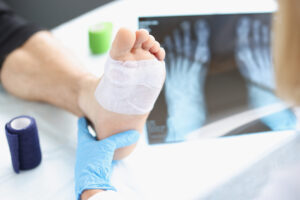Your Guide to Treating and Caring for Diabetic Wounds

It is no secret that diabetes patients have to pay attention to the risks of ulcers and be aware of the proper ways to care for their wounds. The American Podiatric Medical Association even reports that almost 15 percent of diabetic patients who suffer from foot ulcers should be hospitalized. In addition, most amputations start with unaddressed foot wounds and ulcers.
This is why proper diabetic wound care and management are essential in ensuring a favorable outcome for the patient. If you or a loved one has diabetes and experiences foot wounds, read on to learn about the best treatment methods to prevent further complications.
Decreasing Pressure on Your Foot
Off-loading is an integral aspect of healing a foot wound. You must take a break from rigorous physical activities for your injury to recover properly. These include minimizing movements like standing or walking, even for short periods.
You should avoid bearing weight until your wound has completely healed. Devices such as half-shoes and total-contact and removable casts may provide you with additional support if you really need to move around.
Keeping the Wound Covered
Contrary to an old belief, airing out a wound will not help it heal quicker. Instead, you need to cover it and keep it moist to aid in effective healing.
As recommended by your doctor, apply a topical medication to it based on the required number of times every day. Then, wrap your wound with a clean dressing.
Monitoring Blood Sugar Levels
You must closely monitor your blood glucose levels, especially after a recent foot wound. This is because a high blood sugar level will cause your cell walls to stiffen, impacting blood flow and slowing down the wound’s healing process.
Given this, you should pay attention to your blood sugar in keeping up with your diet and nutrition. It will ensure the proper and quick healing of your wound.
Preventing Diabetic Wounds
Although wounds are quite common among people with diabetes, they are not necessarily unavoidable. You can always choose to be proactive in preventing injuries and regularly check for blisters, bruises, cuts, redness, and sores on your feet or between your toes. If that is too difficult for you, ask the help of someone in your household to examine your feet.
More importantly, you can add a layer of protection against wounds by being mindful of your overall health. People at a greater risk of diabetic wounds are those facing any of the following:
- Diabetic neuropathy
- Excessive alcohol intake
- High blood sugar or cholesterol
- History of foot deformities and wounds
- Poor circulation
- Smoking history
Conclusion
You must consult with your doctor about the best way of managing your risks. There are facilities that offer specialized wound treatments, including diathermy, dynamic pressure relief mattresses, e-stim, and wound VAC therapy.
In choosing a center for your wound treatment needs, it is best to go for one that has board-certified and experienced nurses and vascular surgeons. They are professionals who can closely monitor your symptoms and efficiently care for your wounds. They must also answer any questions you may have about your condition.
If you need a diabetic management facility in Morristown, check out Morristown HC. We are a premier nursing home serving as a bridge between hospital and home. We dedicate ourselves to delivering clinical excellence with warmth and compassion for each of our patients. Reach out to us today!